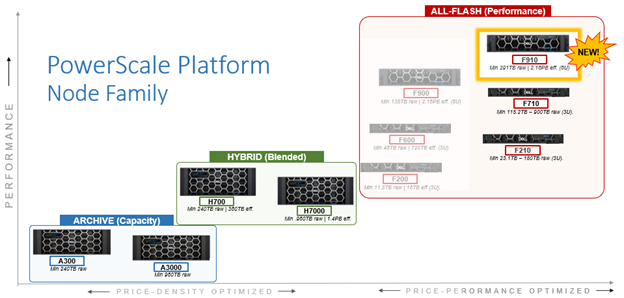Building on the success of the recent PowerScale F710 and F210 and OneFS 9.8 releases comes the widely anticipated launch of the new high-end PowerScale F-series hardware platform. This new F910 all-flash node adds significant density, capacity, and horsepower to the PowerScale all-flash family.

Based on the latest generation of Dell’s PowerEdge R760 platform, the F910 boasts a range of Gen4 NVMe SSD capacities, paired with a Sapphire Rapids CPU, a generous helping of DDR5 memory, and PCI Gen5 100GbE front and back-end network connectivity – all housed within a compact, power-efficient 2RU form factor chassis.
Here’s where these new nodes sit in the current hardware hierarchy:

This new F910 node will supersede the F900, rounding out the all-flash platform refresh, and further extending PowerScale’s price-performance and price-density envelopes.
The PowerScale F910 node offers a substantial hardware evolution from the previous generation, while also focusing on environmental sustainability, reducing power consumption and carbon footprint. Housed in a 2RU ‘Smart Flow’ chassis for balanced airflow and enhanced cooling, the F910 offers twenty four NVMe drives with 3.85 TB or 7.68 TB TLC and 15.36 TB or 31 TB QLC SSD options.
The F910 also includes in-line compression and deduplication by default, further increasing its capacity headroom and effective density. Plus, using Intel’s 4th gen Xeon ‘Sapphire Rapids’ CPUs results in 19% lower cycles-per-instruction, while PCIe Gen 5 quadruples throughput over Gen 3, and the latest DDR5 DRAM offers greater speed and bandwidth – all netting up to 90% higher performance per watt. Additionally, like the F710 and F210, the new F910 includes the new 32 GB Software Defined Persistent Memory (SDPM) file system journal, in place of NVDIMM-n in prior platforms, thereby saving a DIMM slot on the motherboard too.
On the OneFS side, the recently launched 9.8 release delivers a dramatic performance bump – particularly for the all-flash platforms. OneFS 9.8 benefits from latency-improving sharding and parallel thread handling enhancements to its locking infrastructure and protocol heads – on top of the ‘direct write’ non-cached IO boost that 9.7 delivered for the all-flash NVMe platforms.
This combination of generational hardware upgrades plus OneFS software advancements results in dramatic performance gains for the F910 – particularly for streaming reads and writes, which see a 2x or greater improvement over the prior F900 platform. This makes the F910 an ideal candidate for demanding workloads such as M&E content creation and rendering, high concurrency and low latency HPC workloads such as chip design (EDA), high frequency trading, and all phases of generative AI workflows, etc.
Scalability-wise, the F910 requires a minimum of three nodes to form a cluster (or node pool), with up to a maximum of 252 nodes, and the basic specs for the new platform includes:
| Component | PowerScale F910 |
| CPU | Dual–socket Intel Sapphire Rapids, 2.6GHz, 24C |
| Memory | 512GB DDR5 DRAM |
| SSDs per node | 24 x NVMe SSDs |
| Raw capacities per node | 92TB to 737TB |
| Drive options | 3.84TB, 7.68TB TLC and 15.36TB, 30.72TB QLC |
| Front-end network | 2 x 100GbE or 25GbE |
| Back-end network | 2 x 100 GbE |
Note that the F910 also has node compatibility with its predecessor and can therefore coexist with legacy F900s within the same node pool.
In the next article, we’ll dig into the technical details of the new platform. But, in summary, when combined with OneFS 9.8, the new PowerScale all-flash F910 platform quite simply delivers on density, efficiency, flexibility, performance, scalability, and value!